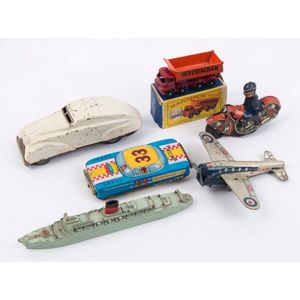Vintage Tinplate Toys and Die Cast Models Lot
Selection with Mettoy tinpate wind-up monoplane (broken propeller, no key), British made friction tinplate Policeman-on-Motorcycle, Japanese made 'Venezuela 33' tinplate friction racing car, Triang-Minic die cast model of RMS Caronia, Matchbox model of Hoveringham tipper truck (boxed) and a friction tinplate 1930s Cadillac; 1930s-60s era; condition variable. (6 items)
You must be a subscriber, and be logged in to view price and dealer details.
Subscribe Now to view actual auction price for this item
When you subscribe, you have the option of setting the currency in which to display prices to $Au, $US, $NZ or Stg.
This item has been sold, and the description, image and price are for reference purposes only.
- Diecast - The toy is made by by pouring molten metal into a closed metal die or mould. The first metal used was a lead alloy, but the finsihed product was very soft and broke easily, and was replaced with an alloy of zinc mixed with small amounts of aluminium and copper.
- Friction Motors in Toys - A friction motor, also known as a push and go is a type of motor that uses friction to create motion. It is commonly found in toys, particularly in vehicles such as cars and trains. The motor works by using a spring-loaded mechanism that is activated when the toy is pushed or pulled along a flat surface. The movement of the toy causes the friction between the wheels and the surface to turn the gears inside the motor, which then propels the toy forward.
Friction motors are known for their simplicity and low cost, making them a popular choice for children's toys. They are also easy to use, as they do not require any batteries or electrical power to operate.
However, there are some drawbacks to friction motors. They can wear out over time, especially if the toy is used frequently. They also have limited speed and power, and the motion can be affected by the surface on which the toy is used.
This item has been included into following indexes:
